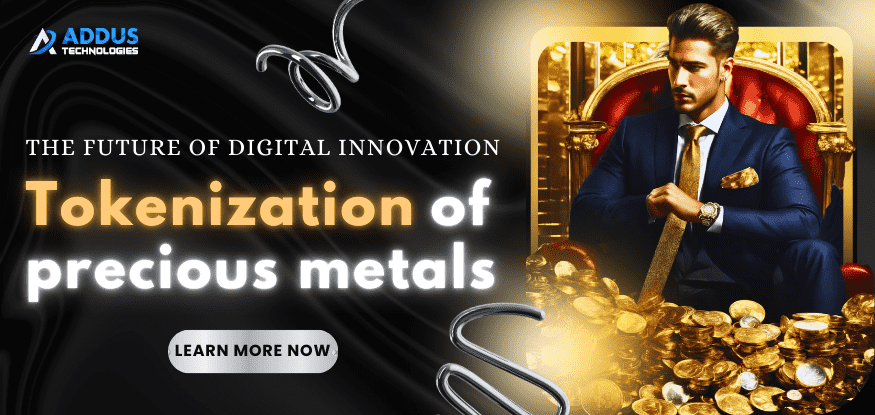Tokenization Of Precious Metals – The Future Of Digital Innovation

In Web3 trends, precious metals create tokens that match the metal’s value. For example, two tokens equals two gold grams. These tokens are sold to investors. The physical metal is stored safely, but users cannot access it. These tokens can be traded on other blockchain platforms where investors exchange tokens. The token’s price relies on the metal’s value. In this blog, we will examine the metals tokenization in detail.
What Is Tokenization?
Tokenization creates tokens that represent real physical assets. These tokens show that the owner has a certain amount of the physical asset. For example, Owning a gold token means you own part of the physical gold, which is stored securely on the blockchain. The blockchain records every transaction to prevent manipulation. This ensures security for investors
Process Of Tokenizing Precious Metals
The process of tokenizing precious metals has several steps. Here’s a simple breakdown:
Buying the Metal:
A person or company buys precious metals like gold or silver. The metal is then kept safe in a secure vault.
Making Tokens:
Digital tokens are created to represent the metal. Each token stands for a specific amount of the metal.
Registering on Blockchain:
The tokens are registered on a blockchain. This makes a secure and permanent record of who owns the tokens.
Selling the Tokens:
The tokens are sold to investors. Investors can buy these tokens on digital platforms.
Trading and Exchanging:
Investors can trade or exchange the tokens on digital platforms. The value of the token matches the metal’s price.
Traditional vs. Tokenized Precious Metals
Ownership Proof
In traditional precious metals, you get a physical certificate or receipt as proof of ownership. Losing this paper can cause problems. You might have to undergo a long process to prove you own the metal again. With tokenized precious metals, ownership proof comes through a digital token on the blockchain. This token acts as your digital certificate. Losing it is less risky. You can retrieve it utilizing your digital wallet’s recovery options.
Storage
Storing traditional precious metals can be hard. People use physical vaults or safes. Tokenized precious metals are kept in digital wallets. No need for physical storage, vault fees, or insurance. Metals are safe from theft because they are digital.
Liquidity
Liquidity measures how easily you can trade a precious metal. Traditional metals take time to sell. Large amounts often need brokers to help. Tokenized precious metals offer high liquidity. You can trade them 24/7 on digital exchanges. This means you can buy or sell whenever you want. Transactions are fast and take only minutes.
Accessibility
Traditional precious metals have geographic limits. You might need to be in a specific place to buy or sell them. If you live far away, it can be hard to access them. Cross-border transactions can also be tricky. Tokenized precious metals have global accessibility. You can access them via the Internet. There are no restrictions to invest.
Ownership
Buying traditional precious metals usually means buying whole units. For example, you might have to buy a full ounce of gold. Fractional ownership is rare and not easy to find. This is a barrier for smaller investors. Tokenized precious metals make fractional ownership easy. You can own small fractions of metal. This lowers entry barriers, letting more people invest. Even with a small amount of money, you can own a fraction.
Transaction Speed
Transactions with traditional precious metals are slow. They involve paperwork and verification. The process can take weeks. Tokenized precious metals offer fast transactions. They are digital so you can buy or sell instantly. There’s no need for paperwork or meetings. This speed is a major benefit of tokenization.
Transparency
Transparency in traditional precious metals is limited. It often depends on third parties like brokers or banks. You have to trust these intermediaries for accurate information. The supply chain is also less visible. Tokenized precious metals offer high transparency. Every transaction is recorded on the blockchain. The data is clearer, reducing the chances of fraud.
Costs
Traditional precious metals come with high costs. These include transaction, insurance, and storage fees. Brokers or dealers charge premiums. These costs add up and reduce your overall return. Tokenized precious metals have lower costs. Fewer intermediaries mean lower payments. Users do not need to spend for physical storage or insurance. Thus it is cost-effective.
Security
Security is a big concern with traditional precious metals. There’s a risk of theft, especially at home. Even in vaults, there’s a small risk of physical theft. Tokenized precious metals offer strong security through cryptographic measures. Your digital assets are protected by encryption. Since they are digital, you must secure your digital wallet from hackers.
Benefits Of Precious Metal Tokenization
Tokenization provides many benefits for investors.
Accessibility:
Tokenization allows you to invest small amounts in precious metals. This opens up opportunities for people worldwide to buy gold or silver.
Liquidity:
It is easier to trade tokens. You can trade them on digital platforms anytime. Unlike physical metals, tokens can be sold quickly.
Security:
Blockchain technology ensures secure transactions. Token ownership is recorded on the blockchain, reducing fraud risks.
Transparency:
The blockchain provides transparent ownership. You can view all transactions related to the token. This builds trust among investors.
Ownership:
Tokenization lets you own a fraction of a precious metal. Users are not required to buy a whole silver or gold bar. This makes investing more affordable.
Future Of Tokenization In Precious Metals
Increased Adoption:
More companies will likely offer tokenized precious metals. This will attract more investors.
Integration with Financial Systems:
Tokenized assets may be integrated into traditional financial systems. This will make it easier to trade tokens.
Development of New Technologies:
New technologies could enhance the security and efficiency of tokenization. This will likely draw more investors to the market.
Global Expansion:
Tokenization is expected to spread to more countries. This will create an international market for tokenized precious metals.
Conclusion
Tokenizing precious metals is a useful investment in the future. Converting physical assets into digital tokens is trending. Addus is a leading Asset Tokenization Development Company. Our skilled team ensures your tokens are backed by real metal bars. We use advanced blockchain technology for safe and clear transactions. We guide you in buying, selling, and swapping tokenized metals. Our platform is made for all types of investors. We use a simple web3 approach to invest in tokenized metals. This is a strong investment for the future. Contact us today to succeed with tokenization.
